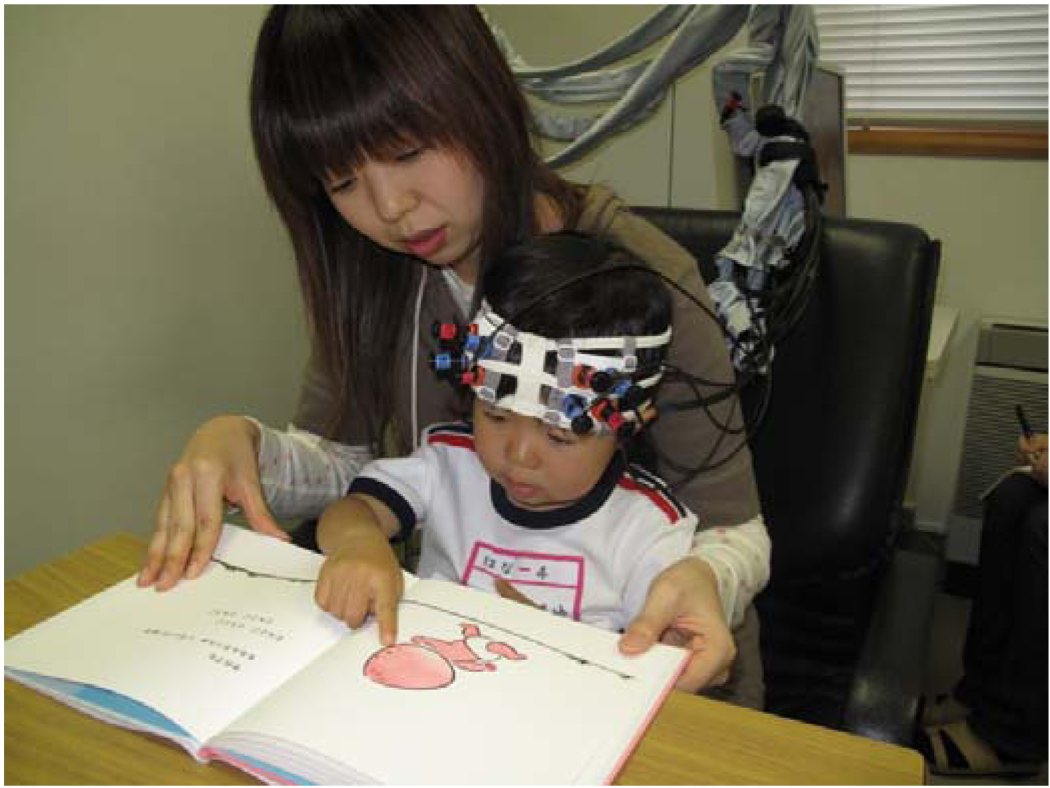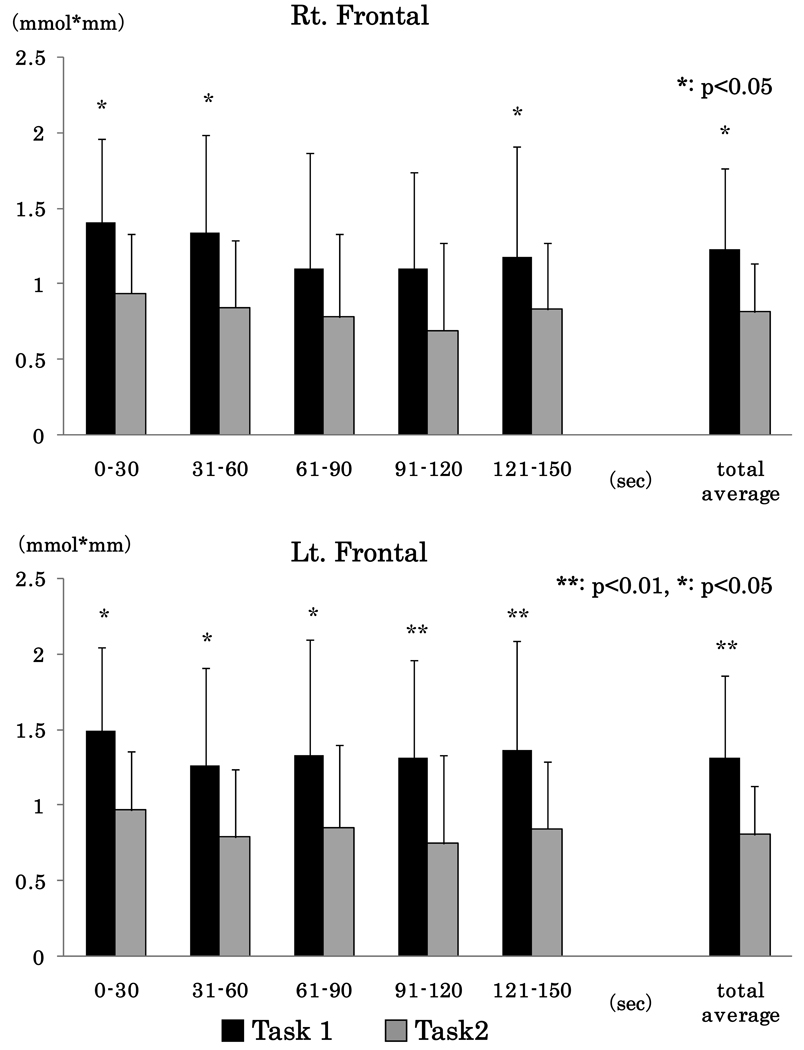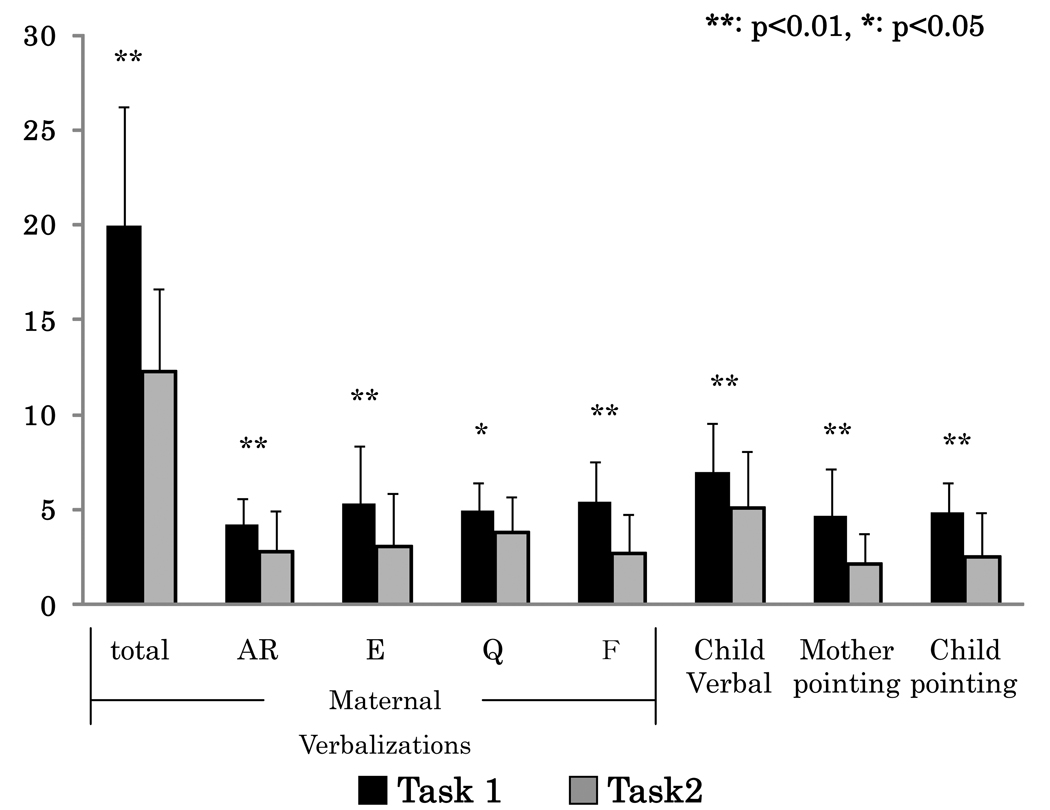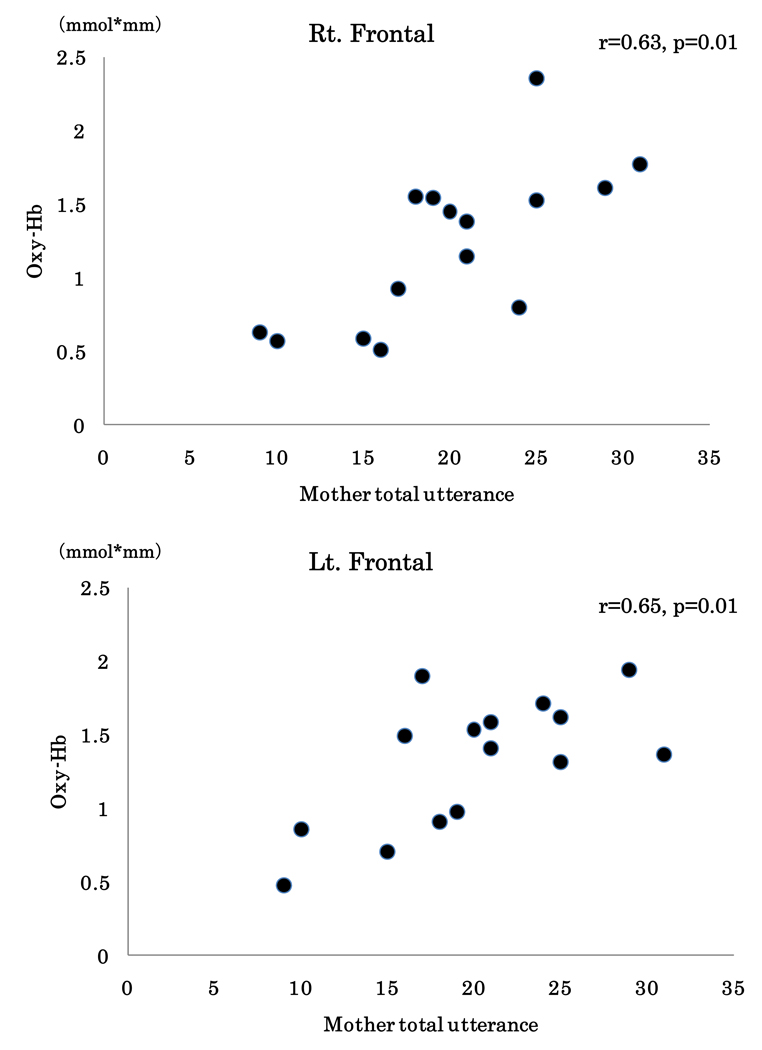Abstract
Aim
This study was to measure changes in frontal brain activation in young children during picture book reading with their mothers.
Methods
The cross-sectional sample consisted of 15 young Japanese children (8 girls and 7 boys, mean age 23.1±3.4). Two experimental tasks were presented as follows: Task 1 (picture book reading with their mothers); Task 2 (viewing of book-on-video). Duration of task stimulus was 180 sec and the 60 sec interval was filled. Brain activation was measured using an optical topography system.
Results
Significant increases in oxy-Hb were observed in both right and left frontal areas in response to Task 1 compared to Task 2. There were significant correlations between child’s brain activity and mothers’ and children’s verbal – nonverbal behaviors.
Conclusion
There was greater frontal lobe activation in children when they were engaged in a picture book reading task with their mothers, as opposed to passive viewing of a videotape in which the story was read to them. Social and verbal engagement of the mother in reading picture books with her young child may mediate frontal brain activity in the child.
Keywords: picture book reading, verbal – nonverbal behaviors, frontal brain activation, near-infrared spectroscopy (NIRS)
INTRODUCTION
Several studies have suggested that picture book reading with parents is an interactive activity which is highly beneficial in promoting children’s learning as well as language and literacy skills. Longitudinal research has also increased our understanding about specific language and emergent literacy skills that may be enhanced by the experience of picture book reading (1–5). Furthermore, picture book reading seems to correlate with children's later understanding of mental states (6).
Although maternal engagement with children in picture book reading is thought to facilitate children’s cognitive development, little is known about the brain activation patterns of young children when their mothers read picture books with them. Recently, Near Infrared Spectroscopy (NIRS) has been used to measure changes in functional brain activity in human subjects, including early infants and children. The NIRS technique utilizes changes in blood volume and hemoglobin oxygenation as indices of neural activation (7–11).
Aim
The purpose of this study was to measure hemodynamic responses in the frontal lobes of young children using NIRS during picture book reading with their mothers. Specifically, we compared the engagement of the mother with her young child, including verbal and non-verbal communication behaviors between mother and child during picture book reading, to viewing of a book-on-video, and assessed their effects on frontal brain activation in the child. Further, the mothers’ and children’s verbal and nonverbal behaviors during picture book reading were analyzed for associations with frontal lobe activity, to reflect upon frontal brain hemodynamic responses during mother-child engagement. We sought to add to the insights on the neural mechanisms by which the mother may foster cognitive development through sharing of picture book reading with her young child.
METHODS
Subjects
We evaluated 15 young children (8 girls and 7 boys) ranging in age from 18 to 30 months (mean age 23.1±3.4) and their mothers (mean age 29.0±2.9 year) from volunteers attending Seirei Christopher University (Figure 1). Families were Japanese middle- to upper-class socioeconomic status. This study was based on informed consent from parents and approved by the Ethics Committee of Seirei Christopher University (approval No. 0912).
Figure 1. Experimental set-up and procedure.
Brain activation was measured using a Hitachi ETG-100 optical topography system, in which two probes arrayed 2×2, and mounted on a flexible cap, were placed over the right and left frontal areas of each child’s head.
| Task | Non-task interval (baseline) |
Task stimulation | Non-task interval (baseline) |
Task stimulation |
|---|---|---|---|---|
| Duration (Sec) | 60 | 180 | 60 | 180 |
Task 1 (picture book reading) was engagement in picture book reading with their mothers. Task 2 (video viewing) was viewing of the book-on-video (included generic female voice) on a 19-inch LCD monitor. Duration of task stimulus was 180 sec, preceded by a 60-sec non-task interval. During the non-task interval, meaningless animation was displayed on the monitor. Children were randomized to begin with Task 1 followed by Task 2, or to begin with Task 2 followed by Task 1. Each child was given one trial.
Procedure
Design of the study was cross-sectional. Two experimental tasks were presented as follows, while the children were monitored by NIRS: Task 1(picture book reading) - engagement in picture book reading with their mothers; Task 2 (video viewing) - Viewing of a videotape on a 19-inch LCD monitor, on which the same picture book story was displayed and read by a generic female voice Children were randomized to begin with Task 1 followed by Task 2, or to begin with Task 2 followed by Task 1. Randomization was performed by simple drawing of lots (to begin with task 1 or 2). Duration of task stimulus was 180 sec, preceded by a 60-sec non-task interval. Figure 1 depicts the experimental set-up and procedure. All children were comfortably seated on a chair or their mother’s lap during the tasks in NIRS study room. Children’s and mothers’ behaviors were recorded using video recordings during the experimental period.
Measurement of brain activation
Brain activation was measured using a Hitachi ETG-100 optical topography system. This instrument measures time courses of the levels of oxyhemoglobin (oxy-Hb), deoxyhemoglobin (deoxy-Hb) and total hemoglobin (total-Hb) at multiple channels with 0.1-s time resolution. The rationale for this approach rests on the concept that neural activation in response to a stimulus results in increased energy demands in the area activated. In response to the demand for energy, cerebral blood flow increases to the activated brain areas. Changes in blood flow lead to an increase in blood volume and can be assessed by measuring local concentrations of oxy-Hb and deoxy-Hb. The summated changes in oxy-Hb and deoxy-Hb are found to increase following brain activation. We used two probes arrayed 2×2, and mounted on a flexible cap, which were placed over the right and left prefrontal region of each hemisphere, including Fp1 and Fp2 based on the international 10--20 system for recording EEG. The distance between the emitting and detecting fibers was set at 2 cm. Each pair of adjacent emitting and detecting fibers defined a single measurement channel, which allowed the measurement of oxy-Hb and deoxy-Hb changes at 4 channels for each measurement area. Average task-related changes of oxy-Hb signals from an arbitrary zero baseline at the start of the measurement period were calculated. The 151–180 sec epoch was excluded from analysis, because three mothers out of all participants did not complete reading of the entire book during the Task 1 period, and twelve mothers completed the reading before 180 sec. Children were assessed for excessive head and body motion during the tasks by using video recordings and examiners’ observations. In four cases where there were motion artifacts, children were retested on the same day or within several days.
Picture book
A Japanese picture book (book name; “Don Doko Momon-chan”, writer; Kazuhiko Toyota, publisher; Doushinsya, Tokyo, Japan ) was selected from popular contemporary children’s interests. This book is appropriate for young age, 1–3 years children. The story depicts the bond between mother and child by recounting the adventures of a baby named “Momon-chan”. The picture book had a total of 20 pages, with each page consisting of large letters, attractive pictures and short sentences (2–3 sentences per page).
Mothers’ and Children’s Verbal and non-verbal behaviors
Mothers’ utterances were scored from videotapes. The verbal analysis consisted of classifying each mother’s utterances into one of four categories adapted from Senechal et al.’s study (12), as follows: Attention-recruiting, Elaborations, Question, or Feedback. Utterances consisting of reading the text in the picture book were excluded from the verbal analysis. Attention-recruiting was defined as an utterance used to attract the child’s attention to the book or a particular aspect of the book. Elaboration was a label, description, or comment. Question was an utterance requesting some kind of response, either from the child or from oneself (that is, parents may ask questions and provide the answers). Feedback consisted of utterances made in answer or response to one’s own question (e.g., when child fails to answer) or to a child’s vocalization, in correcting or commenting on the child’s vocalizations. Child verbalizations included words used to label book illustrations, responses to parent’s questions, self-framed questions, and comments. Coding of verbalizations was conducted by two research assistants, who also coded an overlapping 10% of the data. Kappa values for these behaviors ranged from 0.85 to 0.94, with a mean of 0.92. Nonverbal behaviors were counted from mothers’ and child’s pointing behaviors. Pointing behaviors to the books were assessed from videotapes. Pointing was defined when the child’s index finger was extended and used to approach or indicate foci of interest on the page. Reliability in scoring was established by two research assistants with mean percent agreement 95% for mothers’ pointing behavior and 94 % for child’s pointing behavior.
Statistical analysis
Statistical comparisons of time course of oxy-Hb values for the two tasks were performed by two-way ANOVA (general linear model) with repeated measures, followed by post hoc Tukey test to detect the individual differences. Comparison of total average oxy-Hb values, and mother’s and child’s verbal and non-verbal behaviors between two tasks was performed based on paired t-test. Correlation between values of oxy-Hb and verbal and non-verbal behaviors were analyzed by Pearson product moment correlation coefficients. P < 0.05 was considered statistically significant. All statistical analysis were performed with SPSS version 16.0J for Windows software (SPSS Japan, Tokyo, Japan).
RESULTS
Time course and total average of oxy-Hb values
Oxy-Hb signals were calculated from an arbitrary zero baseline at the start of each measurement period. Figure 2 shows the time course of oxy-Hb values averaged over all children for each task, and total averages of oxy-Hb values during task stimulation. Time course of oxy-Hb values in both right and left frontal area were significantly increased in Task 1 compared with Task 2 in both frontal areas (Rt. Frontal area; F(1, 14)=7.62, p=0.02, Lt. frontal area; F(1, 14)=20.18, p=0.01). Also, total averages of oxy-Hb values in both areas were significantly higher in Task 1 versus Task 2 (p<0.01). There were no significant differences in time course and total average of oxy-Hb values based on the seating position of the child (i.e. predominantly sat on their mother’s lap or the chair).
Figure 2. Time course and total average oxy-Hb values.
Average task-related changes of oxy-Hb signals from an arbitrary zero baseline at the start of the measurement period were calculated for each 30-sec epoch. The results of task–related changes of oxy-Hb values between the two tasks conditions are presented above for the right (upper figure) and left (lower figure) frontal areas. Time course changes of oxy-Hb values were significantly increased in response to the picture book reading versus video viewing in both frontal areas. Similarly, total averages of oxy-Hb values in both hemispheres were observed in picture book reading compared to video viewing.
Mothers’ and children’s verbal behaviors and non-verbal behaviors
Values of mothers’ and children’s verbal behaviors are shown in Figure 3. Frequency of mothers’ verbalizations in all categories, and children’s verbal responses were higher in Task 1 compared with Task 2. Amount of mothers’ and child’s pointing behaviors were also higher in Task 1 compared with Task 2. Mothers’ and children’s verbal and pointing behaviors did not differ significantly based on the child’s seating position.
Figure 3. Mothers’ and Children’s Verbal and Non-verbal Behaviors.
Frequency of mothers’ and children’s vocalizations and their pointing behaviors were significantly higher in frequency in the picture book reading task compared to the video viewing task. AR=Attention-recruiting; E=Elaborations, Q=Question, and F=Feedback.
Correlation between values of oxy-Hb and mothers’ and children’s verbal behaviors during picture book reading
Figure 4 displays the correlations between total average of oxy-Hb values and mothers’ verbalizations (number of utterances). Total average of oxy-Hb values were significantly and positively correlated with number of mothers’ utterances in both frontal areas. Mothers’ verbalizations (Elaboration, Question) were significantly correlated with total average of oxy-Hb values in right frontal areas (p<0.05, respectively). Mothers’ verbalizations (Attention-recruiting, Question, Feedback) were significantly correlated with total average of oxy-Hb values in left frontal areas (p<0.05, respectively) as well. In addition, children’s verbal behaviors were significantly correlated with total average of oxy-Hb values in both frontal areas (p<0.05).
Figure 4. Correlation between average values of oxy-Hb and mothers’ and children’s verbal behaviors during picture book reading.
Correlation between values of oxy-Hb and mothers’ verbal behaviors during picture book reading task are shown. Significantly positive correlations between average values of oxy-Hb and mothers’ verbal behaviors (total utterance, feedback) were observed in right frontal area. There were also significantly positive correlations between average values of oxy-Hb and mothers’ verbal behaviors (total utterance, elaboration, feedback) and child vocalizations observed in left frontal area.
DISCUSSION
This study found that mothers’ engagement with their young children during picture book reading was consistently associated with increased neural activity of frontal lobes in the children. Brain imaging studies have suggested important roles for the frontal lobes in cognitive processes such as executive function, attention, memory, socio-emotional development and language (13–15). Furthermore, researchers and clinicians have suggested that picture book reading is an important activity which promotes children’s language and literacy skills (1–6). High-frequency cortical activity in humans and animals has been linked to a wide variety of higher cognitive processes. Benasich AA et al. suggested that individual differences in the distribution of frontal gamma power during rest were highly correlated with concurrent language and cognitive skills at all ages, better inhibitory control, as well as more mature attention shifting abilities (16). Our findings suggest that picture book reading might foster cognitive, learning and language development as mediated by activation of frontal areas.
Comparison of brain activation between Task 1 (picture book reading) and Task 2 (video viewing) demonstrated significantly higher values of oxy-Hb in picture book reading compared to video viewing. This result showed that picture book reading with the mother was associated with increased functional activation in the frontal lobe, compared to passive video viewing, suggesting that frontal regions are functionally differentiated by picture book reading and video viewing. A possible explanation of the result is that video viewing might lead to activation of non-frontal areas (e.g. occipital and /or temporal areas), which were not assessed in this experimental protocol. A previous MEG study with adults showed higher primary motor cortex activation during observation of live rather than video motor acts (17). Shimada S, et al. also suggested that the infant's motor areas aged 6- to 7-month-old were significantly activated when observing a live person performing an action, while this was not evident in TV viewing (18).
There were significantly positive correlations between changes in oxy-Hb values and amount of mothers’ and children’s verbal–nonverbal behaviors during picture book reading. This result suggests that the richness of the interactions between mother and child facilitates brain activation of frontal area. There is extensive empirical evidence to support a positive relationship between sensitivity in early mother-infant interaction and increased infant cognitive status. Many researchers have also indicated that positive, early relationships between children and caregivers contribute to neural connections that facilitate children’s long-term developmental success. Specific interactions during picture book reading are important for learning early literacy rules/conventions and children’s higher language and cognitive skills in the preschool and primary school years (4–5, 20–24). Furthermore, Kuhl et al. demonstrated that between 9 and 10 mo of age, infants showed phonetic learning from live, but not prerecorded, exposure to a foreign language, suggesting that the ability to discriminate foreign-language phonetic units does not require long-term listening and is enhanced by social interaction (19). Our findings suggest that the stimulation of language and cognitive skills by enriched mother-child interaction might be mediated through higher frontal brain activation in the young child.
There were several limitations in this initial study. First, the sample size was small. Second, habituation of the child to the second presentation of the book (either the video viewing or reading with the mother, as children were randomized to have Task 1 or 2 presented first) was possible. Third, it was unclear whether the increased frontal oxy-Hb was caused directly by mother's reading or by the mother-child interaction during reading. As shared reading is meant to be an interactive and enjoyable activity, it will be difficult to uncouple reading with a young child from interaction, without causing some element of distress in the child who wants to interact with the mother. Future studies could be designed to examine the effects of interaction, e.g. in structured play.
In conclusion, there was greater frontal lobe activation in young children when they were engaged in a picture book reading task with their mothers, as opposed to passive viewing of a videotape. This finding suggests that the social and verbal engagement of the mother in reading picture books may stimulate frontal brain activity in the child. Our results extend previous findings of the mother’s role in stimulating the child’s language and cognitive development, by documenting higher frontal brain reactivity in the child when the mother engages in child in picture-book reading.
Table 1.
Subjects' background
| sex (boy / girl) | 7 (47%) / 8 (53%) |
| age (months) | 23.1 (3.4) |
| mother's age (year) | 29.0 (2.9) |
| sibling (yes) | 6 (40%) |
| daily reading book (times/week) | 10.5 (4.4) |
Fifteen young children and their mothers participated in this study.
ACKNOWLEDGMENT
Dr Loo acknowledges the support of the National Institutes of Health/National Institute of Child Health and Human Development (grant 1 K08 HD051894) and the Foundation for Psychocultural Research-UCLA Center for Culture, Brain, and Development.
References
- 1.Bus AG, van Ijzendoorn MH, Pellegrini AD. Joint book reading makes for success in learning to read: A meta-analysis on intergenerational transmission of literacy. Rev Educ Res. 1995;65:1–21. [Google Scholar]
- 2.DeBaryshe BD. Joint picture book reading correlates of early oral language skill. J Child Lang. 1993;20:455–461. doi: 10.1017/s0305000900008370. [DOI] [PubMed] [Google Scholar]
- 3.Sulzby E, Teale WH. Young children’s storybook reading: Longitudinal study of parent–child interaction and children’s independent functioning (Final report to the Spencer Foundation) Ann Arbor: University of Michigan; 1987. ERIC Document Reproduction Service No. ED 334541. [Google Scholar]
- 4.Bus AG, van Ijzendoorn MH. Affective dimension of mother–infant picturebook reading. J Sch Psycholy. 1997;35:47–61. [Google Scholar]
- 5.Arnold DH, Lonigan CJ, Whitehurst GJ, Epstein JN. Accelerating language development through picture book reading: Replication and extension to a videotape training format. J Educ Psychol. 1994;86:235–243. [Google Scholar]
- 6.Adrián JE, Clemente RA, Villanueva L. Mothers' use of cognitive state verbs in picture-book reading and the development of children’s understanding of mind: a longitudinal study. Child Dev. 2007;78:1052–1067. doi: 10.1111/j.1467-8624.2007.01052.x. [DOI] [PubMed] [Google Scholar]
- 7.Baird AA, Kagan J, Gaudette T, Walz KA, Hershlag N, Boas DA. Frontal lobe activation during object permanence: data from near-infrared spectroscopy. Neuroimage. 2002;16:1120–1125. doi: 10.1006/nimg.2002.1170. [DOI] [PubMed] [Google Scholar]
- 8.Carlsson J, Lagercrantz H, Olson L, Printz G, Bartocci M. Activation of the right fronto-temporal cortex during maternal facial recognition in young infants. Acta Paediatr. 2008;97:1156–1158. doi: 10.1111/j.1651-2227.2008.00886.x. [DOI] [PubMed] [Google Scholar]
- 9.Taga G, Asakawa K, Maki A, Konishi Y, Koizumi H. Brain imaging in awake infants by near-infrared optical topography. Proceedings of the National Academy of Sciences of the United States of America. 2003;100:10722–10727. doi: 10.1073/pnas.1932552100. [DOI] [PMC free article] [PubMed] [Google Scholar]
- 10.Watanabe H, Homae F, Nakano T, Taga G. Functional activation in diverse regions of the developing brain of human infants. Neuroimage. 2008;43:346–357. doi: 10.1016/j.neuroimage.2008.07.014. [DOI] [PubMed] [Google Scholar]
- 11.Aslin RN, Mehler J. Near-infrared spectroscopy for functional studies of brain activity in human infants: promise, prospects, and challenges. J Biomed Opt. 2005;10:11009. doi: 10.1117/1.1854672. [DOI] [PubMed] [Google Scholar]
- 12.Senechal M, Cornell EH, Broda LS. Age-related differences in the organization of parentinfant interactions during picture book reading. Early Child Res Q. 1995;10:317–337. [Google Scholar]
- 13.Casey BJ, Giedd JN, Thomas KM. Structural and functional brain development and its relation to cognitive development. Biological psychology. 2000;54:241–257. doi: 10.1016/s0301-0511(00)00058-2. [DOI] [PubMed] [Google Scholar]
- 14.Chayer C, Freedman M. Frontal lobe functions. Curr Neurol Neurosci Rep. 2001;1:547–552. doi: 10.1007/s11910-001-0060-4. [DOI] [PubMed] [Google Scholar]
- 15.Redcay E, Haist F, Courchesne E. Functional neuroimaging of speech perception during a pivotal period in language acquisition. Dev Sci. 2008;11:237–252. doi: 10.1111/j.1467-7687.2008.00674.x. [DOI] [PubMed] [Google Scholar]
- 16.Benasich AA, Gou Z, Choudhury N, Harris KD. Early cognitive and language skills are linked to resting frontal gamma power across the first 3 years. Behav Brain Res. 2008;195:215–222. doi: 10.1016/j.bbr.2008.08.049. [DOI] [PMC free article] [PubMed] [Google Scholar]
- 17.Jarvelainen J, Schurmann M, Hari R. Activation of the human primary motor cortex during observation of tool use. Neuroimage. 2004;23:187–192. doi: 10.1016/j.neuroimage.2004.06.010. [DOI] [PubMed] [Google Scholar]
- 18.Shimada S, Hiraki K. Infant's brain responses to live and televised action. Neuroimage. 2006;32:930–939. doi: 10.1016/j.neuroimage.2006.03.044. [DOI] [PubMed] [Google Scholar]
- 19.Kuhl PK, Tsao FM, Liu HM. Foreign-language experience in infancy: effects of short-term exposure and social interaction on phonetic learning. Proc Natl Acad Sci U S A. 2003;22:9096–9101. doi: 10.1073/pnas.1532872100. [DOI] [PMC free article] [PubMed] [Google Scholar]
- 20.Sénéchal M, LeFevre J. Parental involvement in the development of children's reading skill: A five-year longitudinal study. Child Dev. 2002;73:445–460. doi: 10.1111/1467-8624.00417. [DOI] [PubMed] [Google Scholar]
- 21.National Scientific Council on the Developing Child. Young Children Develop in an Environment of Relationships. Working Paper No. 1. 2004 Retrieved from www.developingchild.net/pubs/wp/environment_of_relationships.pdf.
- 22.Weigel DJ, Martin SS, Bennett KK. Mothers’ literacy beliefs: Connections with the home literacy environment and pre-school children’s literacy development. Journal of Early Childhood Literacy. 2006;6:191–211. [Google Scholar]
- 23.Bus AG, van IJzendoorn MH. Patterns of attachment infrequently and infrequently reading mother-child dyads. J Genet Psychol. 1992;153:395–403. [Google Scholar]
- 24.Parker FL, Boak AY, Griffin KW, Ripple C, Peay L. Parent-child relationship, home learning environment, and school readiness. School Psych Rev. 1999;28:413–425. [Google Scholar]






